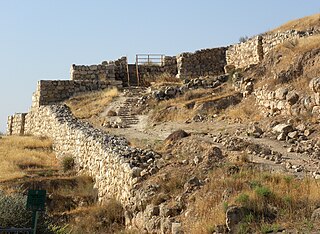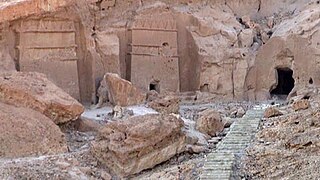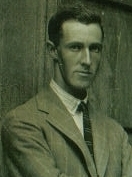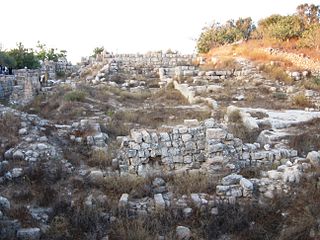
Lachish was an ancient Canaanite and Israelite city in the Shephelah region of Israel, on the South bank of the Lakhish River, mentioned several times in the Hebrew Bible. The current tell (ruin) by that name, known as Tel Lachish or Tell ed-Duweir ,, has been identified with the biblical Lachish. Today, it is an Israeli national park operated and maintained by the Israel Nature and Parks Authority. The park was established on lands of the depopulated Palestinian village of Qobebet Ibn ‘Awwad which was north of the Tel. It lies near the present-day moshav of Lakhish.

Midian is a geographical place mentioned in the Hebrew Bible and Quran. William G. Dever states that biblical Midian was in the "northwest Arabian Peninsula, on the east shore of the Gulf of Aqaba on the Red Sea", an area which he notes was "never extensively settled until the 8th–7th century B.C."

Kiriath-Jearim was a city in the Land of Israel. It is mentioned 18 times in the Hebrew Bible. The biblical place was identified with Abu Ghosh.

Dhiban, known to the Moabites as Dibon, is a Jordanian town located in Madaba Governorate, approximately 70 kilometres south of Amman and east of the Dead Sea. Previously nomadic, the modern community settled the town in the 1950s. Dhiban's current population is about 15,000, with many working in the army, government agencies, or in seasonal agricultural production. A number of young people study in nearby universities in Karak, Madaba, and Amman. Most inhabitants practice Islam.

The Zayit Stone is a 38-pound (17 kg) limestone boulder discovered on 15 July 2005 at Tel Zayit (Zeitah) in the Guvrin Valley, about 50 kilometres (31 mi) southwest of Jerusalem. The boulder measures 37.5 by 27 by 15.7 centimetres and was embedded in the stone wall of a building. It is the earliest known example of the complete Phoenician or Old Hebrew script as it had developed after the Bronze Age collapse out of the Proto-Canaanite alphabet.

The Gezer calendar is a small limestone tablet with an early Canaanite inscription discovered in 1908 by Irish archaeologist R. A. Stewart Macalister in the ancient city of Gezer, 20 miles west of Jerusalem. It is commonly dated to the 10th century BCE, although the excavation was unstratified and its identification during the excavations was not in a "secure archaeological context", presenting uncertainty around the dating.

William M. Schniedewind holds the Kershaw Chair of Ancient Eastern Mediterranean Studies and is a Professor of Biblical Studies and Northwest Semitic Languages at the University of California, Los Angeles.

Avraham Biran was an Israeli archaeologist, best known for heading excavations at Tel Dan in northern Israel. He headed the Institute of Archaeology at Hebrew Union College in Jerusalem for many years.
Michael D. Coogan is lecturer on Hebrew Bible/Old Testament at Harvard Divinity School, Director of Publications for the Harvard Semitic Museum, editor-in-chief of Oxford Biblical Studies Online, and professor emeritus of religious studies at Stonehill College. He has also taught at Fordham University, Boston College, Wellesley College, and the University of Waterloo (Ontario). Coogan has also participated in and directed archaeological excavations in Israel, Jordan, Cyprus, and Egypt, and has lectured widely.
Jeffrey R. Chadwick is an American professional archaeologist and university professor. He serves as Jerusalem Center Professor of Archaeology and Near Eastern Studies at the Brigham Young University Jerusalem Center in Israel, and as Associate Professor of Religious Education at Brigham Young University in Utah, USA. He is also senior field archaeologist and director of excavations in Area F at the Tell es-Safi/Gath Archaeological Project in Israel.

Gerald Lankester Harding was a British archaeologist who was the director of the Department of Antiquities of Jordan from 1936 to 1956. His tenure spanned the period in which the Dead Sea Scrolls were discovered and brought to public awareness. Without his efforts many of the scrolls might have disappeared into private collections never to be seen again.

Samaria was a city in the historical region of Samaria that served as the capital of the northern Kingdom of Israel during the 9th and 8th centuries BCE. Towards the end of the 8th century BCE, possibly in 722 BCE, Samaria was captured by the Neo-Assyrian Empire and became an administrative center under Assyrian, Babylonian, and Persian rule. During the early Roman period, the city was expanded and fortified by Herod the Great, who renamed it “Sebastia” in honor of emperor Augustus.

The W. F. Albright Institute of Archaeological Research (AIAR) is an archaeological research institution located in East Jerusalem. It is the oldest American research center for ancient Near Eastern studies in the Middle East. Founded in 1900 as the American School of Oriental Research, it was renamed in 1970 after its most distinguished director and the father of biblical archaeology, William F. Albright. Its mission is to develop and disseminate scholarly knowledge of the literature, history, and culture of the Near East, as well as the study of civilization from pre-history to the early Islamic period.

Prof. Christopher A. Rollston is a scholar of the ancient Near East, specializing in Hebrew Bible, Greek New Testament, Old Testament Apocrypha, Northwest Semitic literature, epigraphy and paleography.
Stephanie Mary Dalley FSA is a British Assyriologist and scholar of the Ancient Near East. She has retired as a teaching Fellow from the Oriental Institute, Oxford. She is known for her publications of cuneiform texts and her investigation into the Hanging Gardens of Babylon, and her proposal that it was situated in Nineveh, and constructed during Sennacherib's rule.
Daniel Edward Fleming is an American biblical scholar and Assyriologist whose work centers on Hebrew Bible interpretation and cultural history, ancient Syria, Emar, ancient religion, and the interplay of ancient Near Eastern societies. Since 1990, he has served as a professor of Hebrew Bible and Ancient Near Eastern Studies in the Skirball Department of Hebrew and Judaic Studies at New York University, where he has spent his whole career.

Wadi Feynan or Wadi Faynan is a major wadi and region in southern Jordan, on the border between Tafilah Governorate and Aqaba and Ma'an Governorates. It originates in the southern Jordanian Highlands with the confluence of Wadi Dana and Wadi Ghuweyr, and drains into the Dead Sea via Wadi Araba.
Khirbat Faynan, known in late Roman and Byzantine texts as Phaino or Phaeno, is an archaeological site in Wadi Faynan, southern Jordan. It lies just south of the Dead Sea in Jordan. The site was an ancient copper mine that overlooks two Wadis and is the location of one of the best and most well preserved ancient mining and metallurgy districts in the world.












